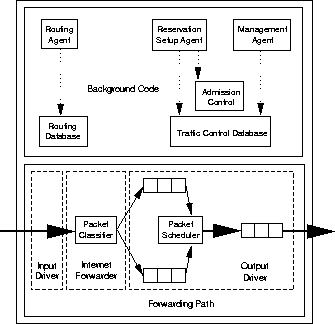




Next: Resource ReSerVation Protocol---RSVP
Up: Internet Integrated Services
Previous: Integrated Services Model
The traffic control functions within a host or router are provided by the packet scheduler,
the packet classifier, and the admission control.
Figure  on page
on page  demonstrates how these elements fit into the implementation reference model.
demonstrates how these elements fit into the implementation reference model.

Figure: Integrated services implementation reference model for routers.
- Packet Classifier.
-
To support traffic control and accounting, each incoming packet is first identified by
information gained from filter specs as belonging to a particular flow, and then mapped
into a corresponding service class.
All packets within one class are treated equally.
The choice of the appropriate class is made locally at each router and reflects the
importance that a router gives to an individual flow.
The packet classification can be performed by looking at the source and destination host address,
the protocol number, and the port fields.
To reduce the overhead, the addition of a flow-id field in the IP-layer packet
header is proposed, which allows a short-cut classification of the packets.
- Packet Scheduler.
-
The packet scheduler mainly manages the forwarding of different packet streams by
(re-)ordering the output queue according to the importance of the packets' classes.
Therefore, the packet scheduler must be part of the output driver of an operating system,
namely of that part, which manages the output packet queues. The packet
scheduling algorithm follows for example priority-based, round-robin, or
weighted-fair-queueing (WFQ) approaches.
Packet scheduling also includes the decision which packets to drop in case of overload.
Furthermore, the packet scheduler ensures that a sending host behaves according to its
promised traffic pattern. This function is called policing or
enforcement.
The packet scheduler can also act as a traffic estimator:
it measures properties of the outgoing packet streams. This information is used to generate
traffic statistics which support packet scheduling and admission control decisions.
- Admission Control.
-
The admission control decides whether QoS requirements of new flows can be met
without violating earlier guarantees. The admission control algorithm must be invoked at
each router along the path of the new flow.
The decision of admittance can be based either on worst-case assumptions about existing and new flows,
or on measures of the actual traffic. The latter approach incurs a higher risk of overload,
but can utilise the available bandwidth considerably better.
Admission control can also be employed to enforce administrative policies for QoS arbitration.





Next: Resource ReSerVation Protocol---RSVP
Up: Internet Integrated Services
Previous: Integrated Services Model
tspeuker@cip.informatik.uni-erlangen.de
 on page
on page  demonstrates how these elements fit into the implementation reference model.
demonstrates how these elements fit into the implementation reference model.





 on page
on page  demonstrates how these elements fit into the implementation reference model.
demonstrates how these elements fit into the implementation reference model.





